#anduril industries
Text
ANDURIL INDUSTRIES INTRODUCES THE PULSAR FAMILY OF ELECTROMAGNETIC WARFAR SYSTEMS
Anduril Industries has recently introduced the Pulsar: Family of Electromagnetic Warfare Systems.
Anduril Industries state ” Anduril Industries is excited to announce Pulsar, a first-of-its-kind family of modular, multi-mission-capable electromagnetic warfare (EW) systems that utilize artificial intelligence at the tactical edge to rapidly identify and defeat current and future threats across…
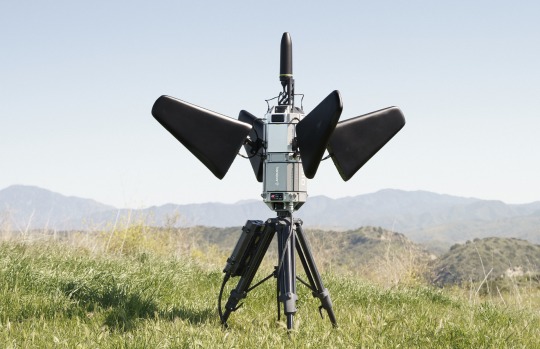
View On WordPress
2 notes
·
View notes
Text
The US Air Force Gears Up for Next-Gen Air Combat with GA-ASI and Anduril
The US Air Force Gears Up for Next-Gen Air Combat with GA-ASI and Anduril
#India #defence #defense #USA #GeneralAtomics #GASI #AndurilIndustries #Anduril #CCA #airforce #defencenews
US Air Force’s Collaborative Combat Aircraft (CCA) project: The future of air combat took a significant step forward with the US Air Force‘s selection of General Atomics Aeronautical Systems Inc. (GA-ASI) and Anduril to develop and manufacture Collaborative Combat Aircraft (CCA) prototypes. This program aims to revolutionize aerial warfare by deploying fleets of low-cost, modular, and highly…

View On WordPress
#Anduril Industries#Collaborative Combat Aircraft CCA#General Atomics#United States Air Force#US Air Force#USAF
0 notes
Text
The U.S. defense industrial base just got a $20 billion shot in the arm from the national security supplemental bills passed by Congress last week. But although officials and experts believe the funding will provide a much-needed jolt to military production and help open up new factory lines, some say it’s still not enough to respond to China, Russia, and terror threats at the same time.
“We have begun—begun—to rebuild the industrial base with the supplementals,” Bill LaPlante, the Pentagon’s acquisition chief, said at an event last week. “Calling it a wartime footing, no.”
The biggest need? Money. Officials and experts say that the United States needs more of it, lots more, to make the real investments. At the peak of World War II, the United States was spending nearly 40 percent of its GDP on defense. It’s down to less than a tenth of those spending levels now. And the need to spend more has gone up with the Chinese spending more—and with Russian factories working around the clock.
“It’s still shy by quite a bit [for] what you would need to get our stockpiles in the right shape, get our industrial base in the right shape, help the Taiwanese, and get the Ukrainians in a position that they can get some leverage in negotiations,” said Jeb Nadaner, a former U.S. deputy assistant secretary of defense for industrial policy. “If the benchmark is against the calendar and the clock, we’re still falling behind every month. And that can’t go unnoticed by China.”
But the jolt will allow the United States to surge artillery production and solve key bottlenecks.
One is the production of solid rocket motors used for everything from Javelin anti-tank weapons that can hit a tank from a little over a mile away to intercontinental ballistic missiles that can propel warheads across the Atlantic and Pacific oceans if a U.S. war with Russia or China ever went nuclear.
Aerojet Rocketdyne, which was recently bought out by L3Harris Technologies for nearly $5 billion, was one of only a few suppliers. But the supplemental gives several billions of dollars for companies, such as Orbital ATK, to expand their solid rocket motor facilities.
And it provides money from the Defense Production Act—the same law that Washington used to force U.S. manufacturers to produce more masks, gloves, and face shields during the coronavirus pandemic—to build out a second tier of rocket motor suppliers, including X-Bow Systems in Texas; Ursa Major in Colorado; and Adranos in Mississippi, which was recently bought out by defense technology company Anduril. The idea is to fast-track work that wasn’t going to be done until at least 2026, if not 2027 or 2028, according to a congressional aide, who spoke on condition of anonymity to talk about military contracts that hadn’t been made public.
There’s also about $100 million to help Williams, one of the only American makers of cruise missile motors, speed up production in Michigan. Those motors are used in the long-range anti-ship missile that might one day help Taiwan fend off Chinese landings; the armor-piercing joint air-to-surface standoff missile; the Tomahawk land attack missile that is the U.S. Navy’s weapon of choice; and the Harpoon missile that the Ukrainians have used in the Black Sea.
There’s also money to build factories for ball bearings, printed circuit boards, and other subcomponents for the $311 billion that the Pentagon wants to spend in the upcoming year to develop new weapons. Processor assemblies, castings, forgings, microelectronics, and seekers for munitions have been major bottlenecks. And there are recruitment and attrition problems almost across the board, from welders at shipyards to rocket engineers, a generational problem that might need vocational-training fixes at the high school level and up.
But with some Democrats pushing back on the Biden administration’s $850 billion Pentagon budget proposal as too costly, there’s also a focus on smaller attritable capabilities that don’t need a whole lot of start-up capital or defense industrial muscle to get moving.
There’s a ton of counter-drone money, about $600 million, that will go toward Coyotes, a small drone capable of intercepting other drones, and Roadrunners, an air defense munition that takes off vertically—just like the F-35 fighter jet variant flown by the U.S. Marines.
Some members, such as House Armed Services Committee ranking member Adam Smith, have advocated for ending production of ground-launched nuclear weapons. Congress is also trying to scrap old weapons, including F-15 fighter jets, the A-10 Warthog aircraft, and littoral combat ships used by the Marines. Smith is even curious about using microwaves as the next generation of air defense instead of directed energy.
The United States is also torn between near-term needs, like 155 mm artillery ammunition, and long-term needs—like a sixth-generation fighter jet that will follow the F-35. “There are going to have to be some trade-offs between preparing for a near-term fight and near-term deterrence and probably making some trade-offs on some next-generation weapons systems,” said Seth Jones, the senior vice president and director of the international security program at the Center for Strategic and International Studies in Washington, D.C.
Russia’s invasion of Ukraine is still going to be a major factor in setting requirements for the U.S. military. “We’re going to be selling 155 [mm] like a drunken sailor for a few years,” said Mark Montgomery, a senior fellow at the Foundation for Defense of Democracies. “The Western alliance needs the U.S. to crank 155 [mm] for a decade.”
Other weapons used in the early days of Ukraine’s defense of Kyiv are likely to hit a plateau in production. Those include Javelin systems; the High Mobility Artillery Rocket System, or HIMARS; and Stinger anti-aircraft missiles, which the Pentagon sent to Ukraine in large numbers early in the war and are also included in the supplemental, but which have taken on a secondary role as the fight has been bogged down in trench warfare for months and months.
Allies can help solve some of the bottleneck problems. The United States is co-developing new glide-phase interceptors with Japan as well as co-producing guided multiple-launch rockets with Australia and guidance-enhanced missiles for Patriot air defenses with the Germans. But after the political fights that took the supplemental more than six months to get through Congress, LaPlante and other officials acknowledged that the United States now has an image problem in showing itself to be a reliable torch-bearer for the global defense industrial base.
There’s another major production plateau that members of Congress are trying to stave off: attack submarines. The Biden administration’s proposed budget for the upcoming year slashed funding for one attack submarine. For years, producing two a year had been the standard, even though U.S. shipyards only produce between 1.2 and 1.4 Virginia-class submarines each year, and new variants are 24 to 36 months behind schedule.
And there are dependencies that are difficult—if not impossible—to cut. The United States still buys a significant amount of its titanium from Russia, which is used for everything from landing gears to tank armor, and is only slowly ramping up production of rare earth minerals, which are dominated by China. But the U.S. military’s weapons are ravenous for rare earths: The F-35 needs 900 pounds of rare earths to run, and the Virginia-class submarines need more than 10 times that amount. The military also needs lithium ions used in advanced battery production that China also dominates.
Where Congress and the Pentagon are having more trouble jolting the defense industrial base to life is for weapons that might be used in the Indo-Pacific. The U.S. Army’s precision strike missile that would be used to hit incoming Chinese ships from more than 600 miles out, for instance, is still being developed—the seeker that would find enemy vessels isn’t finished—so there’s no way to ramp up capacity, at least not yet.
But before the United States ramps up industrial capacity, some members of Congress want the Pentagon to take a good, hard look at what’s already on the books.
“Where can we look within the budget and say, wouldn’t we be better to spend more money on these things that we really do need?” Smith said. “So before I get into a discussion about, ‘Gosh, it’d be great if we had another $50 billion,’ where are we spending the money that we have? I think that’s the first question.”
8 notes
·
View notes
Text
This day in history

I'm on tour with my new, nationally bestselling novel The Bezzle! Catch me in TUCSON (Mar 9-10), then SAN FRANCISCO (Mar 13), Anaheim, and more!

#20yrsago EFF is suing the FCC over the Broadcast Flag! https://web.archive.org/web/20040314151119/https://www.eff.org/IP/Video/HDTV/20040309_eff_pr.php
#20yrsago ICANN’s tongue slithers further up Verisign’s foetid backside https://memex.craphound.com/2004/03/09/icanns-tongue-slithers-further-up-verisigns-foetid-backside/
#20yrsago Nader kicks Mastercard’s ass in fair-use fight https://web.archive.org/web/20040401171817/http://lawgeek.typepad.com/lawgeek/2004/03/nader_wins_pric.html
#15yrsago AIG has insured $1.6 trillion in derivatives https://web.archive.org/web/20090312010613/https://www.scribd.com/doc/13112282/Aig-Systemic-090309
#10yrsago Putin your butt https://www.reddit.com/r/pics/comments/1zrchl/check_out_my_3d_printed_putin_butt_plug/?sort=new
#10yrsago Public Prosecutor of Rome unilaterally orders ISPs to censor 46 sites https://torrentfreak.com/italian-police-carry-out-largest-ever-pirate-domain-crackdown-140305/
#5yrsago Palmer Luckey wins secretive Pentagon contract to develop AI for drones https://theintercept.com/2019/03/09/anduril-industries-project-maven-palmer-luckey/
#5yrsago Pentagon reassures public that its autonomous robotic tank adheres to “legal and ethical standards” for AI-driven killbots https://gizmodo.com/u-s-army-assures-public-that-robot-tank-system-adheres-1833061674
#5yrsago Elizabeth Warren reveals her plan to break up Big Tech https://medium.com/@teamwarren/heres-how-we-can-break-up-big-tech-9ad9e0da324c
#5yrssago The US requires visas for some EU citizens, so now all US citizens visiting the EU will be subjected to border formalities too https://www.cbsnews.com/boston/news/us-citizens-need-visa-europe-travel-2021/
#1yrago The AI hype bubble is the new crypto hype bubble https://pluralistic.net/2023/03/09/autocomplete-worshippers/#the-real-ai-was-the-corporations-that-we-fought-along-the-way

Name your price for 18 of my DRM-free ebooks and support the Electronic Frontier Foundation with the Humble Cory Doctorow Bundle.
7 notes
·
View notes
Text
Okay, so remember like six months ago in the tags of a really long meta post where I mentioned that one day I'd get around to writing down all my thoughts about water and fire in the Silmarillion? No. Of course you don't. Neither did I. Buckle up because this is also going to be a long one and hopefully at least halfway coherent.
To start off, a list of things and people in the Silmarillion and LoTR that are associated with fire:
Feanor
The deaths of at least one (two if you prefer crispy Amrod) of the sons of Feanor
The Burning of the Swanships
Balrogs
The Dagor Bragollach ("Battle of the Sudden Flame")
Sauron and Saruman (as former servants of Aule)
Dragons
The death of Gil-galad
Loss of the power of the three elven-rings (ceased when the one ring is dropped in a volcano)
Eol and Maeglin (smiths)
The sun
Maedhros
Aegnor ("sharp-flame")
The Eye of Sauron
Stars
There are not very many happy things on this list. In fact, many of them are straight-up servants of Morgoth. Maeglin, Eol, Maedhros, and the sun are a little more complicated, but the sun marked the end of the first age, which was essentially the high point of history for the Valinorean elves, and Eol, Maedhros, and Maeglin's roles in the narrative are largely destructive. Even Aegnor, who is generally considered one of the good guys, doesn't get a happy ending. I also feel like it's significant that the Silmarils burn the hands of Maglor and Maedhros once they lose their birthright to them. Also, the deaths of most of the house of Finarfin and the house of Fingolfin are associated with fire either directly or indirectly. Fire is a symbol of destruction and loss. Which makes a lot of sense, considering the association of fire with industrialization and machinery, and Tolkiens theme's wrt to nature and its destruction in LoTR. The only thing on the list that's a 100% positive symbol is the stars, which are the domain of Varda and much farther away and less often and less directly associated with fire than the sun.
In contrast, a list of things and people in the Silmarillion and LoTR associated with water:
Ulmo
The Teleri
Nargothrond
Vinyamar
Tuor
The Helcaraxe
The death of Elenwe
Tol Galen
The first-age Minas Tirith
Cuivienen
The Falas
Voronwe
Ecthelion
Earendil
Elwing
Elrond and Elros
Lothlorien and Rivendell are built on rivers
Glorfindel calls of the river for protection from the Ringwraiths
Galadriel possesses Nenya, the ring of water
Cirdan
There's some more in the Akallabeth, but I'm saving that for later.
But there are a lot of good things on that list! Many things that are protectors and healers and symbols of hope! Many of the cities mentioned do fall, and the people mentioned don't always get unequivocally happy endings, but they provide hope and protection nonetheless. Water is protective and generative and healing. The sea is consistently associated with protection and guidance, specifically.
Now, you may have noticed that there are some examples that I did NOT include. This is because, while water = good and fire = bad for the elves, for men, it's sort of flipped. Anduril is the Flame of the West, the lighting of the beacons summons Rohan to the aid of Gondor, Boromir dies and the Fellowship is split at the Falls of Rauros, the One Ring falls into a river and Numenor sinks into the sea. It's not as clear-cut as it is for the elves, and I have a lot less evidence, but I find it really interesting! Men are benefitted by what is driving the elves out, and most of the prominent examples come from LoTR. Fire becomes more of a positive symbol and water becomes more ambiguous as the story moves into the age of Men, and as the power of the elves begins to fade.
Anyway, this is probably, like, the shakiest analysis ever, but I thought it was interesting.
#I was having a conversation with my cousin who's kind of dipping her toes into the silm about the maiar#and we got around to talking about how Aule somehow got betrayed by BOTH of his maiar that we know of#and I remembered this as i was explaining that it fits thematically
42 notes
·
View notes
Text
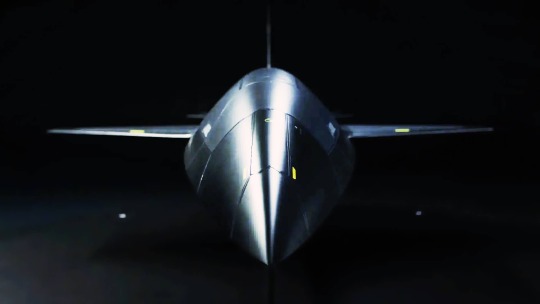
Anduril Is Helping The Air Force To Develop Its Loyal Wingman Drone
Anduril is one of five companies now working on the Collaborative Combat Aircraft program, which is a top priority for the Air Force.
Joseph TrevithickPUBLISHED Jan 25, 2024 12:33 PM EST
Defense contractor Anduril has formally announced that it is one of five companies working on the US Air Force's Collaborative Combat Aircraft (CCA) advanced drone program.
Anduril
Anduril has become the first contractor to formally announce that it supporting the U.S. Air Force's Collaborative Combat Aircraft advanced uncrewed aircraft program. This comes as the service says this program is progressing slower than it would like due to budgetary issues and amid emerging concerns about the cost and capabilities of the future drones.
A brief press release Anduril put out today says it is one five vendors the Air Force has chosen to help develop its future Collaborative Combat Aircraft (CCA). The service said last year that a number of companies were under contract to conduct CCA-related work, but declined to name any of them. Last month, Breaking Defense reported that Boeing, General Atomics, Lockheed Martin, and Northrop Grumman were the other four contractors working on the CCA program, citing anonymous sources. That story added that some of these companies could be eliminated in a down-select later this year.
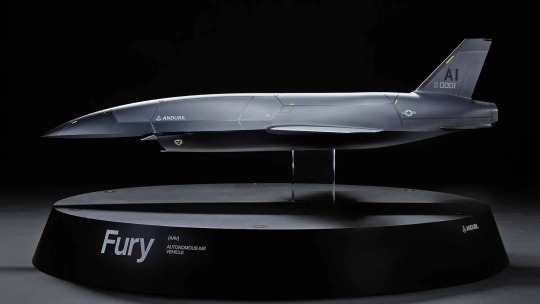
A rendering of Anduril's stealthy Fury drone. The company has not yet disclosed how exactly it is contributing to the CCA program. Anduril
When contacted for more information about exactly how it is now contributing to the CCA development effort, Anduril told The War Zone that it could not currently provide any more details "given sensitivities," which it did not elaborate on. We have also reached out to the Air Force for additional information.
Last year, Anduril did notably acquire small aviation firm Blue Force Technologies, which had been developing an advanced drone called Fury that has long seemed very much in line with the Air Force's CCA requirements. You can read more about the Fury, its expected capabilities, its origins, and Anduril's plans for the design in great detail in this feature The War Zone published last September.
youtube
Anduril also produces Lattice, which it describes as an "artificial intelligence-enabled software platform that enables teams of autonomous systems to dynamically collaborate to achieve complex missions, under human supervision." This could also be very relevant to the CCA program.
youtube
The CCA program is presently focused on the development and acquisition of at least one type of advanced "loyal wingman"-esque drone with a high degree of autonomy. These uncrewed aircraft are expected initially to operate closely together with stealthy Air Force F-35A Joint Strike Fighters and the future crewed sixth-generation Next Generation Air Dominance (NGAD) combat jet. The drones could potentially operate together with other types of aircraft, including non-stealthy fourth-generation fighters and the B-21 Raider stealth bomber, or independently, in the future. CCA is another element of the larger NGAD family of programs, which also includes new weapons, sensors, networking and battle management suites, advanced jet engines, and more.
"We commend Secretary Kendall and the U.S. Air Force for their leadership and commitment to integrating new technologies into the force," Anduril said in its release today. "We are honored to be the only non-traditional defense company selected to be a part of the CCA program."
The specific mention of being a "non-traditional defense company" here is noteworthy. Large established defense contractors like Lockheed Martin, Northrop Grumman, Boeing, General Atomics, and Raytheon have largely dominated the discussion about CCA-relevant developments in recent years.
youtube
Anduril regularly highlights its position as a 'disruptor' in the U.S. defense industrial space and its novel developmental, production, and general business practices, as you can read more about here. The company has steadily expanded its portfolio, with focuses on artificial intelligence software and smaller drones, since its founding in 2017.
The Air Force has also been touting its efforts to make use of novel contracting and other processes to help accelerate the CCA program. Air Force Lt. Gen. Richard Moore, Jr, the Deputy Chief of Staff for Plans and Programs, spoke about this just yesterday at a public event hosted by the Center for Strategic & International Studies (CSIS) think tank in Washington, D.C.
"The thing about this that's innovative with CCAs, in particular, is the Secretary [of the Air Force Frank Kendall] asked us: 'Please don't go to industry and give them a requirement. The last thing in the world we want to do is tell them what to build. We want to go to them with questions and we want to find out what they can do. What is the art of the possible and what is it that they could provide? And let's allow the envelope to expand by not constraining it with a requirement," Moore said.
"I think what we're starting to see now is that there are a lot of thoughts out there, some of them ... not necessarily from the large defense primes [traditional prime contractors], that really will will be beyond what we would have conceived had we decided to write a requirement," Moore added. "So it is exciting to see what's coming. And I think the the way that this is innovative is something that will transition to other programs. I don't think that this is one and done, because I think that we're going to find it to be wildly successful."
Moore also specifically mentioned "non-traditional sources" supporting the CCA program that had emerged through the Small Business Innovation Research (SBIR) program. SBIR is a U.S. government contracting mechanism that focuses on smaller deals with smaller companies to help foster technical innovation. The initial work on the Fury drone was through SBIR contracts.
All of this being said, the Air Force has made clear that it is not moving ahead with CCA as fast as it wants. The service has blamed this primarily on broader budgetary disputes between President Joe Biden's administration and Congress that are currently impacting the U.S. government as a whole. Secretary of the Air Force Frank Kendall has been particularly outspoken over the years about the problems that short-term spending packages, commonly called continuing resolutions (CR), rather than full annual budgets, impose on the U.S. military broadly.
"We're going to be limited in terms of forward progress based on the CR," Kristyn E. Jones, the senior official currently performing the duties of the Under Secretary of the Air Force, also said at yesterday's CSIS event, speaking alongside Lt. Gen. Moore. "CCA, as I mentioned – you know, we've made some progress being able to award contracts to some of the initial designers, but we can't ramp that."
The Air Force has said in the past that it wants to acquire at least 1,000 CCAs, and likely many more, and that it wants to begin major production of the drones within the next five years. At present, the expected cost of a single CCA is estimated to be around one quarter to one third of the unit price of an F-35 stealth fighter. This would put the price point for one of these future drones at between roughly $20.5 million and $27.5 million, based on public data about current F-35 unit prices.
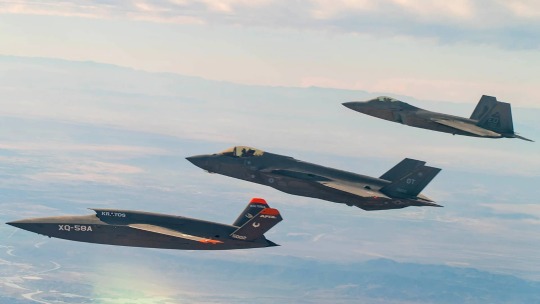
An F-35A, at center, flies together with a Kratos XQ-58 Valkyrie drone, at left, and an F-22 Raptor stealth fighter, at right, during a test. USAF
The 1,000 CCA figured is based around a notional concept of operations involving a pair of the drones operating together with each of 200 NGAD combat jets and 300 F-35As. The Air Force has also previously said that a single crewed aircraft could oversee more CCAs in the future.
In addition, despite Moore's comments about the Air Force trying not to set firm requirements for the future CCAs, the service is clearly working to define several key parameters. From what has been disclosed so far, the CCA effort looks to be leaning toward designs with less range and higher performance than had previously been envisioned, and that will be at the high end of the expected unit cost range as a result. This, in turn, has already prompted Congress to voice concerns about the direction of the program.
The Air Force has made clear that the CCA program, however it might continue to evolve, is central to its future operational vision. The service sees the drones as especially critical for providing advanced capabilities in high volumes at a relatively low cost, a concept it currently refers to as "affordable mass." This kind of capacity is seen as particularly essential for success in any future high-end conflict, such as one against China in the Pacific.
In the meantime, much about the overall CCA program still seems to be in flux. The Air Force does now seem be working to coalesce the effort around a core group of contractors, including Anduril.
Contact the author: [email protected]
5 notes
·
View notes
Text
Great news everybody! New evil weeaboo tech guy just dropped! And my favourite image is applicable once again!

So, November 6th was a sort of holiday for the Sword Art Online community. Like with Blade Runner, which took place in the distant future of 2019, Sword Art Online began on November 6th, 2022.
(Sword Art Online is a science fiction isekai novel series that was adapted into anime, manga, movies, and games.)
On this fabled day, gamers put on their NerveGear VR headsets, devices that connected to the brain to provide a “full dive” virtual reality experience. But once they logged on, they found out that they couldn’t log out. The creator’s avatar announced to them that if they tried to take the headset off, they would die, and that if they died in the game, they’d die in real life too. The headset would use microwaves to fry the player’s brain.
So what did our guy do?
“The good news is that we are halfway to making a true NerveGear. The bad news is that so far, I have only figured out the half that kills you,” Luckey said.
THE FOOL COULD ONLY FIGURE OUT THE KILLING HALF
You will never be Akihiko Kayaba, you slimy nerd
And as is par for the course, he completely missed the point of Sword Art Online.
Aside from his predictably anarcho-capitalist political views, he is co-founder of defence contractor Anduril Industries
Any defence contractor is naturally disgusting, but this one is deliciously ironic, too! Because what do they specialise in? According to LinkedIn, "national security, defense technology, and artificial intelligence". They use AI in drones for border security. And the villains of Sword Art Online's 4th arc are American defence contractors who want to steal the AI technology developed by fictional company Rath to use to pilot drones.
Anyway, he’s the one who made the deal with Facebook “Meta”, to sell Oculus to them while retaining a huge stake in the company. Before he sold it to Facebook, the Oculus Quest 2 was the affordable VR headset, as it included the necessary computing power, so you didn’t need to connect it to your own device. However, then he made the Facebook deal, to help Zuckerberg’s Metaverse take off. The Oculus Quest 2 is now the Meta Quest 2, and if you buy it, Facebook gets access to all of your data and will surveil you while you use it. You can still buy a version not connected to Meta- rebranded as being “for business use”, and it’s functionally the same- but it costs double. This move was to force the Metaverse onto people.

Basically, he's saying "one day you will be able to die in the Metaverse <3".
I hope he puts on his headset and it kills him.
4 notes
·
View notes
Text
Anduril Announces Menace-X for Mobile Distributed Command and Control
Anduril Industries is thrilled to announce Menace-X, an expeditionary command, control, communications, and computing (C4) vehicle-based system that extends strategic and operational-level capabilities to the tactical edge. Built to operate in denied, disrupted, intermittent, and limited (DDIL) communication environments, Menace-X enables resilient command and control of complex mission sets, such as deep sensing and coordination of maritime surface fires, in a highly-mobile form factor. Current C2 solutions require large logistical footprints, significant set-up time, and specialized training. With logistics and communications networks of forward-deployed and stand-in forces increasingly at risk of adversary targeting, warfighters need to quickly disperse, maneuver, and communicate across distributed forces to sustain operations at the edge while under multi-domain attack. This is where Menace-X comes into play.
#military #defense #defence #militaryleak
Anduril Industries is thrilled to announce Menace-X, an expeditionary command, control, communications, and computing (C4) vehicle-based system that extends strategic and operational-level capabilities to the tactical edge. Built to operate in denied, disrupted, intermittent, and limited (DDIL) communication environments, Menace-X enables resilient command and control of complex mission sets,…

View On WordPress
0 notes
Text
Anduril moves ahead in Pentagon program to develop unmanned fighter jets | TechCrunch
Anduril Industries has taken another step forward in his quest to become the next great American Prime Minister, this time beating out major defense companies to develop and test a small unmanned fighter jet prototype.
The venture capital darling beat out Boeing, Lockheed Martin and Northrop Grumman in the deal under the Air Force’s Cooperative Combat Aircraft (CCA) program. General Atomics was…
View On WordPress
0 notes
Link
Anduril Industries has taken another step forward in its quest to become the next great American prime, this time by beating out major defense companies to develop and test small unmanned fighter jet prototypes. The venture capital darling beat out Boeing, Lockheed Martin and Northrop Grumman on the deal, under the Air Force’s Collaborative Combat […] © 2024 TechCrunch. All rights reserved. For personal use only.
0 notes
Text
Anduril Industries soars into the future of warfare, selected for USAF's CCA project
Anduril Industries USAF’s CCA Programme: The US Air Force (USAF) has taken a bold step towards the future of aerial combat with the selection of Anduril, a non-traditional defense company, to participate in the Collaborative Combat Aircraft (CCA) program. Announced on April 24, 2024, this selection marks a significant shift in the defense industry landscape and opens doors for innovative…
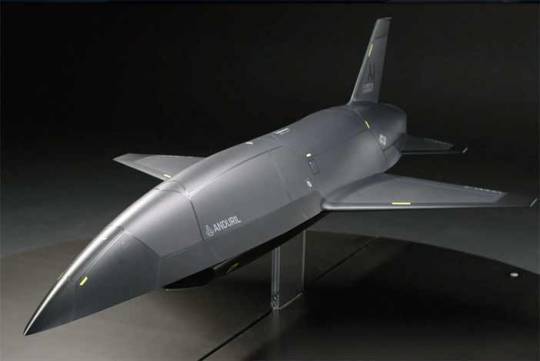
View On WordPress
0 notes
Text
0 notes
Text
Tech Official Pushing TikTok Ban Could Reap Windfall From U.S.–China Cold War
From his perch on a government commission, Jacob Helberg fearmongered about TikTok in Congress. He also works for a giant defense contractor.
— Sam Biddle | March 21 2024

Photo Illustration: Rafael Henrique/SOPA Images/LightRocket via Getty Images
Among The Many Hawks on Capitol Hill, few have as effectively frightened lawmakers over Chinese control of TikTok as Jacob Helberg, a member of the U.S.–China Economic and Security Review Commission. Helberg’s day job at the military contractor Palantir, however, means he stands to benefit from ever-frostier relations between the two countries.
Helberg has been instrumental in the renewed legislative fight against TikTok, according to the Wall Street Journal. “Spearheading the effort to create the bipartisan, bicoastal alliance of China hawks is Jacob Helberg,” the Journal reported in March 2023. The paper noted collaboration between Helberg, previously a policy adviser at Google, and investor and fellow outspoken China hawk Peter Thiel, as well as others in Thiel’s circle. The anti-China coalition, the Journal reported this past week, has been hammering away at a TikTok ban, and Helberg said he has spoken to over 100 members of Congress about the video-sharing social media app.
From his position on the U.S.–China commission — founded by Congress to advise it on national security threats represented by China — Helberg’s rhetoric around TikTok has been as jingoistic as any politician. “TikTok is a scourge attacking our children and our social fabric, a threat to our national security, and likely the most extensive intelligence operation a foreign power has ever conducted against the United States,” he said in a February hearing held by the commission.
Unlike those in government he’s supposed to be advising, however, Helberg has another gig: He is a policy adviser to Alex Karp, CEO of the defense and intelligence contractor Palantir. And Palantir, like its industry peers, could stand to profit from increased hostility between China and the United States. The issue has been noted by publications like Fortune, which noted in September 2023 that Palantir relies heavily on government contracts for AI work — a business that would grow in a tech arms race with China. (Neither the U.S.–China commission nor Palantir responded to requests for comment.)
“It is a clear conflict-of-interest to have an advisor to Palantir serve on a commission that is making sensitive recommendations.”
Experts told The Intercept that there didn’t appear to be a legal conflict that would exclude Helberg from the commission, but the participation of tech company officials could nonetheless create competing interests between sound policymaking and corporate profits.
“It is a clear conflict-of-interest to have an advisor to Palantir serve on a commission that is making sensitive recommendations about economic and security relations between the U.S. and China,” said Bill Hartung, a senior research fellow at the Quincy Institute for Responsible Statecraft and scholar of the U.S. defense industry. “From their perspective, China is a mortal adversary and the only way to ‘beat’ them is to further subsidize the tech sector so we can rapidly build next generation systems that can overwhelm China in a potential conflict — to the financial benefit of Palantir and its Silicon Valley allies.”
Big Tech’s China Hawks
Helberg’s activities are part of a much broader constellation of anti-China advocacy orbiting around Peter Thiel, who co-founded Palantir in 2003 and is still invested in the company. (Helberg’s husband, the venture capitalist Keith Rabois, spent five years as a partner at Thiel’s Founders Fund). Thiel, also an early investor in Pentagon aerospace contractor SpaceX and weaponsmaker Anduril, has for years blasted the Chinese tech sector as inherently malignant — claims, like Helberg’s, made with more than trace amounts of paranoia and xenophobia.
Thiel’s remarks on China are characteristically outlandish. Speaking at the MAGA-leaning National Conservatism Conference in 2019, Thiel suggested, without evidence, that Google had been “infiltrated by Chinese intelligence” — and urged a joint CIA–FBI investigation. In 2021, at a virtual event held by the Richard Nixon Foundation, Thiel said, “I do wonder whether at this point, bitcoin should also be thought [of] in part as a Chinese financial weapon against the U.S.”
For Thiel’s camp, conflict with China is both inevitable and necessary. U.S.–China research cooperation on artificial intelligence, he says, is treacherous, and Chinese technology, generally, is anathema to national security. As he inveighs against Chinese tech, Thiel’s portfolio companies stand by with handy solutions. Palantir, for instance, began ramping up its own Made-in-the-USA militarized AI offerings last year. Anduril executives engage in routine fearmongering over China, all the while pitching their company’s weapons as just the thing to thwart an invasion of Taiwan. “Everything that we’re doing, what the [Department of Defense] is doing, is preparing for a conflict with a great power like China in the Pacific,” Anduril CEO Palmer Luckey told Bloomberg TV last year.
Palantir is making a similar pitch. In a 2023 quarterly earnings call, Palantir Chief Operations Officer Shyam Sankar told investors that the company had China in mind as it continues to grow its reach into the Western Pacific. On another Palantir earnings call, Karp, the company’s CEO and Helberg’s boss, told investors the more dangerous and real the Chinese threat gets, “the more battle-tested and real your software has to be. I believe it’s about to get very real. Why? Because our GDP growth is significantly better than China’s.” Even marketing images distributed by Palantir show the company’s software being used to track Chinese naval maneuvers in the South China Sea.
Thiel is not alone among Silicon Valley brass. At a February 2023 panel event, a representative of America’s Frontier Fund, a national security-oriented technology investment fund that pools private capital and federal dollars, said that a war between China and Taiwan would boost the firm’s profits by an order of magnitude. Private sector contributors to America’s Frontier Fund include both Thiel and former Google chair Eric Schmidt, whose China alarmism and defense-spending boosterism rivals Thiel’s — and who similarly stands to personally profit from escalations with China.
TikTok, Bad! China, Bad!
Repeated often enough, anti-TikTok rhetoric from tech luminaries serves to reinforce the notion that China is the enemy of the U.S. and that countering this enemy is worth the industry’s price tags — even if the app’s national security threat remains entirely hypothetical.
“Just like tech had to convince people that crypto and NFTs had intrinsic value, they also have to convince the Pentagon that the forms of warfare that their technologies make possible are intrinsically superior or fill a gap,” Shana Marshall, an arms industry scholar at George Washington University’s Elliott School of International Affairs, told The Intercept.
“TikTok Threat Is Purely Hypothetical, U.S. Intelligence Admits”
Marshall said bodies like the U.S.–China Economic and Security Review Commission can contribute to such conflicts because advisory boards that encourage revolving-door moves between private firms and government help embed corporate interests in policymaking. “In other words,” she said, “it’s not a flaw in the program, it’s an intentional design element.”
“The tensions with China/Taiwan are tailor made for this argumentation,” Marshall added. “You couldn’t get better cases — or better timing — so grifters and warmongers like Helberg and Schmidt are going to be increasingly integrated into Pentagon planning and all aspects of regulation.”
Forcing divestiture or banning TikTok outright would not trigger armed conflict between the U.S. and China on its own, but the pending legislation to effectively ban the app is already dialing up hostility between the two countries. After the House’s overwhelming support last week of the bill to force the sale of the app from Chinese hands, the Financial Times reported that Chinese foreign ministry spokesperson Wang Wenbin accused the U.S. of displaying a “robber’s logic” through legislative expropriation. An editorial in the Chinese government mouthpiece Global Times decried the bill as little more than illegal “commercial plunder” and urged TikTok parent company ByteDance to not back down.
“There are a lot of defense contractors that are discussing the China threat with an eye out on their bottom line.”
Of course, self-interest is hardly a deviation from the norm in the military-industrial complex. “This is the way Washington works,” said Scott Amey, general counsel at the Project on Government Oversight, a watchdog group. “There are a lot of defense contractors that are discussing the China threat with an eye out on their bottom line.”
Although it’s common for governmental advisory boards like Helberg’s U.S.–China commission to enthusiastically court the private sector, Amey said it would be important for Helberg to make clear when making policy recommendations whether he’s speaking as an adviser to Palantir’s CEO or to Congress, though the disclosure wouldn’t negate Helberg’s personal interest in a second Cold War. Such disclosures have been uneven: While Helberg’s U.S.–China commission bio leads with his Palantir job, the company went unmentioned in the February hearing. Given the ongoing campaign to pass the TikTok bill, Helberg’s lobbying “certainly raises some red flags,” Amey said.
He said, “The industry is hawkish on China but has a financial interest in the decisions that the executive branch or Congress make.”
#The Intercept#China 🇨🇳#US 🇺🇸#US 🇺🇸 — China 🇨🇳 Cold War#TikTok#TikTok Ban in the US 🇺🇸#Jacob Helberg | Fearmongered#Giant Defense Contractor#TikTok Bad! | China 🇨🇳 Bad!#TikTok Threat | Purely Hypothetical | U.S. Intelligence Admits
0 notes
Quote
Anduril’s Lattice is an open software platform capable of being used for a variety of missions and industries — including public safety, security, and defense. Designed to be sensor, network, and system agnostic, Lattice takes data from disparate and distributed sensors, feeds, and systems and moves this data into a single integration layer. In this integration layer, AI, machine learning, and sensor/data processing techniques are used to filter high-value information to users. This filtering enables users to react to the data by tasking other systems such as sensors, vehicles, or other assets within the platform itself.
The capabilities and features of Lattice make for a rapidly-adaptable software platform that is useful for a variety of commercial, public safety, and military applications, including managing ground and maritime surveillance sensors deployed at ports or critical infrastructure sites such as power plants, solar, and wind farms; managing teams of unmanned aircraft systems for public safety, search and rescue, or pipeline monitoring in the oil and gas sector; and intelligent detection and mitigation of unmanned aircraft systems and other airborne threats near airports, private space launch facilities, oil fields, gas pipelines, and other critical infrastructure.
Today, Lattice serves as an AI-enabled software integration and network layer across a variety of legacy systems
Anduril - Anduril’s Lattice: a trusted dual use — commercial and military — platform for public safety, security, and defense
0 notes
Text
Pentagon Increases Investment in AI Accelerator as Autonomous Weapons Systems Become a Reality
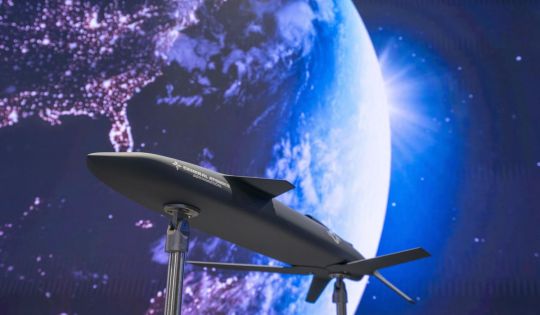
Pentagon Increases Investment in AI Accelerator as Autonomous Weapons Systems Become a Reality
The Challenge of AI Revolution
AI's Impact on Space and Military Operations
Reliability and Decision Making
Future Outlook
Pentagon Increases Investment in AI Accelerator as Autonomous Weapons Systems Become a Reality
NATIONAL HARBOR, Md. — Artificial intelligence employed by the U.S. military has piloted pint-sized surveillance drones in special operations forces’ missions and helped Ukraine in its war against Russia. It tracks soldiers’ fitness, predicts when Air Force planes need maintenance and helps keep tabs on rivals in space.
Pentagon's Ambitious Initiative
Now, the Pentagon is intent on fielding multiple thousands of relatively inexpensive, expendable AI-enabled autonomous vehicles by 2026 to keep pace with China. The ambitious initiative - dubbed Replicator - seeks to “galvanize progress in the too-slow shift of U.S. military innovation to leverage platforms that are small, smart, cheap, and many,” Deputy Secretary of Defense Kathleen Hicks said in August.
The Shift to Autonomous Lethal Weapons
While its funding is uncertain and details vague, Replicator is expected to accelerate hard decisions on what AI tech is mature and trustworthy enough to deploy - including on weaponized systems. There is little dispute among scientists, industry experts and Pentagon officials that the U.S. will within the next few years have fully autonomous lethal weapons. And though officials insist humans will always be in control, experts say advances in data-processing speed and machine-to-machine communications will inevitably relegate people to supervisory roles.
The Challenge of AI Revolution
Replicator highlights immense technological and personnel challenges for Pentagon procurement and development as the AI revolution promises to transform how wars are fought.
AI's Impact on Space and Military Operations
One domain where AI-assisted tools are tracking potential threats is space, the latest frontier in military competition. China envisions using AI, including on satellites, to “make decisions on who is and isn’t an adversary,” U.S. Space Force chief technology and innovation officer Lisa Costa, told an online conference this month.
AI's Role Across Different Military Sectors
Elsewhere, AI’s predictive powers help the Air Force keep its fleet aloft, anticipating the maintenance needs of more than 2,600 aircraft including B-1 bombers and Blackhawk helicopters. Machine-learning models identify possible failures dozens of hours before they happen, said Tom Siebel, CEO of Silicon Valley-based C3 AI. Among health-related efforts is a pilot project tracking the fitness of the Army’s entire Third Infantry Division - more than 13,000 soldiers. Predictive modeling and AI help reduce injuries and increase performance, said Maj. Matt Visser.
Global Impact and Future Challenges
To survive on the battlefield these days, military units must be small, mostly invisible and move quickly because exponentially growing networks of sensors let anyone “see anywhere on the globe at any moment,” Joint Chiefs chairman Gen. Mark Milley observed in a June speech.
PHOTOS: Pentagon steps on AI accelerator as age of lethal autonomy looms
“The argument may be less about whether this is the right thing to do, and increasingly more about how do we actually do it — and on the rapid timelines required,” said Christian Brose, a former Senate Armed Services Committee staff director now at the defense tech firm Anduril.
Challenges in Autonomous Systems Development
To more quickly connect combatants, the Pentagon has prioritized the development of intertwined battle networks - called Joint All-Domain Command and Control - to automate the processing of optical, infrared, radar and other data across the armed services. But the challenge is huge and fraught with bureaucracy. Anduril and Shield AI, each backed by hundreds of millions in venture capital funding, are among companies vying for contracts.
Reliability and Decision Making
The only weapons systems that Shanahan, the inaugural Pentagon AI chief, currently trusts to operate autonomously are wholly defensive, like Phalanx anti-missile systems on ships. He worries less about autonomous weapons making decisions on their own than about systems that don’t work as advertised or kill noncombatants or friendly forces.
Future Outlook
“Regardless of the autonomy of the system, there will always be a responsible agent that understands the limitations of the system, has trained well with the system, has justified confidence of when and where it’s deployable — and will always take the responsibility,” said Craig Martell, the department’s current chief digital and AI officer. “That will never not be the case.”
Read the full article
0 notes
Text
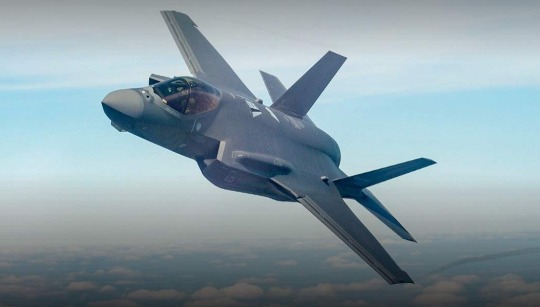
Greece closer to the agreement to buy F-35 fighters
Fernando Valduga By Fernando Valduga 06/03/2023 - 11:55am Military
U.S. Senator Jim Risch, the top Republican on the Senate Foreign Affairs Committee, approved the sale of Lockheed Martin Corp's F-35 fighters to Greece, adding the last signature needed before the deal is concluded.
The agreement received the green light from the committee's chairman, U.S. Senator Bob Menendez, in February, and also secured the approval of Republican Co-President Michael McCaul and Gregory Meeks, the most senior Democrat on the committee, the Hellas Journal reported on Thursday.
Now that the consensus of all four officials has been obtained, the U.S. government will formally notify Congress on the sale of F-35 to Greece and, from then on, the procedure prescribed for the ratification of the defense contract will be followed.
The issue of the sale of F-35 jets to Greece is moving forward with the delivery of the first aircraft between 2028 and 2033, although a Letter of Acceptance (LOA) is still expected on the US side.
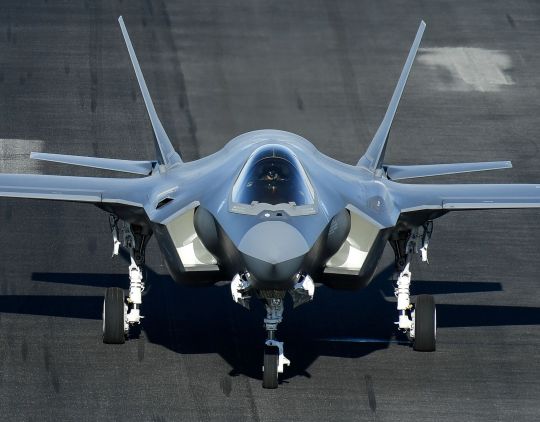
The first installment for the supply of fifth generation F-35 fighters should amount to 350 million euros, after the completion of the deduction of the so-called SSI (safety, supply, information) from the final price of aircraft designed in the US.
Cost estimates can be relatively accurate based on fixed characteristics, such as the number of a total of 20 F-35As that the Hellenic Air Force will receive between 2028 and 2033. The Hellenic Air Force wants a fleet of 40 F-35 Block 4s.
??????? The procedure followed for the approval of defense contracts involves the U.S. State Department first informally probing Congress with the sale proposal. Although not linked to the process, the government usually takes the opinion of Congress seriously and thus avoids confronting it openly in the approval of defense contracts. It is precisely at this stage that the F-16 update that Turkey has been trying to achieve up to this point has stagnated.
Turkey, Greece's rival and NATO member, has not yet received the approval to buy new F-16 fighters, the aircraft it was looking for after the U.S. refused its F-35 proposal to buy S-400 missile systems from Russia.
Tags: Military AviationF-35 Lightning IIHAF - Hellenic Air Force / Greek Air ForceLockheed Martin
Fernando Valduga
Fernando Valduga
Aviation photographer and pilot since 1992, has participated in several events and air operations, such as Cruzex, AirVenture, Daytona Airshow and FIDAE. He has works published in specialized aviation magazines in Brazil and abroad. Uses Canon equipment during his photographic work around the world of aviation.
Related news
MILITARY
Ukrainian Air Force forms new attack squadron with Su-24 bombers with British cruise missiles
03/06/2023 - 16:00
BRAZIL
AMAZON: Brazilian Armed Forces locate aircraft on clandestine runway, filled with drug cargo
03/06/2023 - 11:27
EMBRAER
Embraer hopes to announce this year the first sale of the A-29N to a NATO nation
02/06/2023 - 18:28
MILITARY
USAF C-130J will receive new HUDs for low visibility aerial firefighting
02/06/2023 - 16:00
Textron Systems Aerosonde Small Unmanned Aircraft System (SUAS) (Photo: Textron Systems)
MILITARY
VIDEO: Demonstration of manned-unmanned team (MUM-T) between Textron Systems and Anduril Industries
02/06/2023 - 14:00
MILITARY
AFRL concludes flight test of new laser weapon concept in aircraft
02/06/2023 - 13:00
homeMain PageEditorialsINFORMATIONeventsCooperateSpecialitiesadvertiseabout
Cavok Brazil - Digital Tchê Web Creation
Commercial
Executive
Helicopters
HISTORY
Military
Brazilian Air Force
Space
Specialities
Cavok Brazil - Digital Tchê Web Creation
4 notes
·
View notes